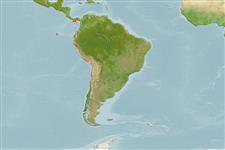Common names from other countries
>
Blenniiformes (Blennies) >
Blenniidae (Combtooth blennies) > Salariinae
Etymology: Scartichthys: Greek, skaritis, -idos = a jewel stone with the colour of the fish scarus (Ref. 45335); gigas: Latin, gigas = giant; refers to the relatively large size of adults (Ref. 10696).
More on author: Steindachner.
Environment: milieu / climate zone / depth range / distribution range
Sinh thái học
Biển gần đáy; Mức độ sâu 0 - 10 m. Tropical; 9°N -
Eastern Pacific: Panama (Ref. 9280) to northern Chile (Ref. 10696).
Bộ gần gũi / Khối lượng (Trọng lượng) / Age
Maturity: Lm ? range ? - 13 cm
Max length : 25.1 cm TL con đực/không giới tính; (Ref. 122662)
Các tia vây lưng cứng (tổng cộng) : 11 - 13; Các vây lưng mềm (tổng cộng) : 16 - 18; Tia cứng vây hậu môn: 2; Tia mềm vây hậu môn: 18 - 20. With fewer than 70 dentary incisors and a reticulated color pattern.
Adults inhabit rocky coasts (Ref. 9280). They feed on plants, small mollusks and crustaceans (Ref. 9280). Oviparous (Ref. 205). Eggs are deposited in mollusk shells or on rocks (Ref. 9280). Larvae are planktonic, often found in shallow, coastal waters (Ref. 94114). Used to prepare a soup called 'borracho' which evokes slight intoxication and tiredness; these effects, however, are of short duration (Ref. 9280).
Oviparous, distinct pairing (Ref. 205).
Hastings, P.A., 1995. Blenniidae. Borrachos. p. 927-930. In W. Fischer, F. Krupp, W. Schneider, C. Sommer, K.E. Carpenter and V. Niem (eds.) Guia FAO para Identification de Especies para lo Fines de la Pesca. Pacifico Centro-Oriental. 3 Vols. FAO, Rome. (Ref. 9280)
IUCN Red List Status (Ref. 130435)
CITES (Ref. 128078)
Not Evaluated
Human uses
Các nghề cá: buôn bán nhỏ
Các công cụ
Special reports
Download XML
Các nguồn internet
Estimates based on models
Preferred temperature (Ref.
115969): 18.1 - 26.8, mean 20.5 (based on 113 cells).
Phylogenetic diversity index (Ref.
82804): PD
50 = 0.5625 [Uniqueness, from 0.5 = low to 2.0 = high].
Bayesian length-weight: a=0.00813 (0.00434 - 0.01522), b=3.02 (2.85 - 3.19), in cm Total Length, based on LWR estimates for this species & (Sub)family-body (Ref.
93245).
Mức dinh dưỡng (Ref.
69278): 3.0 ±0.39 se; based on food items.
Thích nghi nhanh (Ref.
120179): Trung bình, thời gian nhân đôi của chủng quần tối thiểu là 1.4 - 4.4 năm (Assuming tm=1 and Fec=100-1000).
Fishing Vulnerability (Ref.
59153): Low vulnerability (15 of 100).
